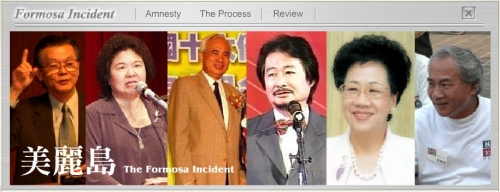|

|
| |
|
National archives are national government materials that are worthy of long-term preservation and the National Archives Administration (NAA) is Taiwan’s central authority of archives. NAA is responsible for the collection, transfer, organization and preservation of national archives, planning of other management operations and related facilities, as well as receiving gifts, safekeeping and procurement of important archives from individuals or organizations.
In order to provide public access to government documents and records and shed light on the truth of historical events, NAA started in 2000 to recruit experts and scholars from different disciplines to visit, review, select, and collect archives of major social and political events such as the 228 Incident and the 921 Earthquake; thus preserving materials of national significance and creating knowledge assets of Taiwan.
|
| |
| I. Government Affairs: National Assembly |
| |

|
| |
| |
 |
| http://theme.archives.gov.tw//en/theme1_1.html |
| |
| Dr. Sun Yat-sen said, “It’s time to let people rule. The Government, founded on the Three Principals of the People, should implement Self-government at County Level, People’s Rights of state management, Separation of Five-powers, and National Assembly.” The Constitution of the Republic of China proclaims that “The National Assembly of the Republic of China, by virtue of the mandate received from the whole body of citizens, in accordance with the teachings bequeathed by Dr. Sun Yat-sen in founding the Republic of China, and in order to consolidate the authority of the State, safeguard the rights of the people, ensure social tranquility, and promote the welfare of the people, do hereby establish this Constitution, to be promulgated throughout the country for faithful and perpetual observance by all.” The function of National Assembly is to, on behalf of all fellow citizens, elect President of ROC, enact and amend the Constitution, and exercise the Right to Consent. The first National Assembly met in Nanking in 1948. The Assembly went dormant in 2000 and became fully defunct in 2005 |
| |
| II. Major Politics: |
| |
| 1. The 228 Incident |

|
| |
| |
 |
| http://theme.archives.gov.tw/en/theme5_1.html |
| |
| On August 29, 1945, the National Government appointed Chen Yi as Chief Executive of Taiwan Province to be in charge of the administration of Taiwan. On October 25, Chen Yi attended the formal surrender ceremony of the Japanese military forces; the nationality of Republic of China was hereafter restored to the Taiwanese people. After the Restoration, Taiwanese people expressed their welcome and support for the government. However, due to the frequent bombardments of Taiwanese facilities by American military forces, it was not easy to obtain raw materials or technicians after the war. The production levels plummeted, inflation soared, and essential goods were in short supply. Moreover, the administrative, judiciary, legislative, and military powers were all under the control of Chen Yi’s office. This centralization of powers was ineffective in rebuilding Taiwan and worsened political situations. The Government and Chen Yi, unfortunately, failed to recognize and alleviate the severity of situations, resulting in the outbreak of the 228 Incident in 1947. |
| |
| 2. The Formosa Incident |
| |

|
| |
| |
  |
| http://theme.archives.gov.tw/en/theme5_2.html |
| |
| This incident had its origins in a protest rally organized by a magazine press. On December 1, 1979, the Formosa Magazine's Kaohsiung services department petitioned the Taiwan Garrison General Headquarters for a memorial assembly at the Rotary's Park on the Day of International Human Rights (December 10), but the application was turned down. Still, the Magazine's propaganda vehicles took to the street on the 9th announcing that the memorial assembly was to be held as scheduled. The assembly therefore became a conflict between the police and the civilians, resulting in massive arrests. Over eighty people were implicated and put on trials, eight of whom were charged with armed rebellions. Years later, ex-President Lee Tung-hui granted official pardons to the convicted of the incident, causing the story that took place in the 1970s to become a hot topic of discussion again. The Incident is viewed by many people as a major milestone in the evolution of democracy and human rights in Taiwan. |
| |
| III. Social Development: The 921 Earthquake |
| |
|

|
| |
| |
 |
| http://theme.archives.gov.tw/en/theme4_2.html |
| |
|
The magnitude 7.3 earthquake that struck central Taiwan on Sept. 21, 1999 was one of the most devastating natural disasters to happen on this island this century. The earthquake, which struck at 1:47 a.m. when most people were sleeping, violently shook the whole island of Taiwan, and was especially felt in the counties of Taichung, Nantou, and Yunlin in central Taiwan. Altogether, the earthquake and thousands of aftershocks killed 2,455 people, injured more than 11,000, and left 50 people missing.
Immediately after the earthquake struck, the Firefighting Administration, by following the Disaster Plan announced by the Executive Yuan, notified all its agencies and personnel to set up the Central Disaster Center. The armed forces were ordered by the Prime Minister to provide assistance to the rescue effort in Nantou Area. International rescue teams also started to arrive in Taiwan and a boy in Taichung was rescued by the Korean team after 87 hours.
More information can be found on the Relieve Disaster Foundation’s website “921: 10th Anniversary of the 1999 Chi-Chi Earthquake.”
|
| |
| Text and images are provided by National Archives Administration |
|